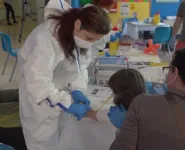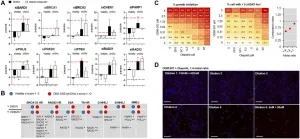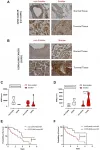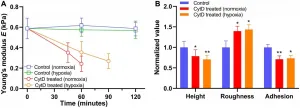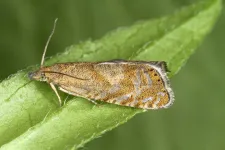(Press-News.org) COLUMBUS, Ohio - When COVID-19 hit, affluent Columbus residents responded by taking significantly fewer trips to large grocery and big-box stores, apparently ordering more online and stocking up when they did go out to shop.
With fewer options available to them, low-income people had to double down on what they had always done: regular trips to the local dollar stores and small groceries to get their family's food.
That's the conclusion of a new study that analyzed traffic to Columbus grocery sellers before, during and after the COVID-19 lockdown.
Dollar stores and small local grocers in neighborhoods housing mostly low-income people of color didn't see as much of a decline in customers during the lockdown as did large grocery and big-box stores, said Armita Kar, lead author of the study and a doctoral student in geography at The Ohio State University.
"Most low-income people still had to shop for groceries in person during the COVID lockdowns and may not have had the economic ability to stock up on food," Kar said.
"They took fewer trips to mid- and high-end grocery stores outside their neighborhood and continued to go regularly to the stores that were nearest to them, which were the dollar stores and local grocers."
The problems faced by poor people during the pandemic lockdown were not new, said study co-author Huyen Le, assistant professor of geography at Ohio State.
"COVID-19 exacerbated the existing problems of unequal access to food for low-income people," Le said.
The study was published online recently in the journal Applied Geography.
The researchers used anonymized and aggregated cell phone location data to analyze 2020 travel patterns to nearly all Columbus area grocery stores (393 in total) during pre-lockdown (Jan 6 - March 15), lockdown (March 16 - April 19) and initial reopening (April 20 - May 31).
The goal was to find out how different kinds of grocery stores were affected by the lockdown and how travel to stores differed between high- and low-income neighborhoods.
Results showed that mid- and high-end grocery stores and big-box food retailers in the city saw their in-person customer levels plunge when COVID-19 lockdowns began, presumably because their mostly affluent clientele could shop online and stock up on supplies, so they went to stores less often.
But dollar stores and smaller independent grocers, particularly in low-income neighborhoods and those housing people of color, saw only a small decline in their customer levels during the lockdown.
When the initial reopening occurred in April, the larger grocery stores and big-box retailers saw their customer numbers recover quickly - with an important caveat.
Most of the returning customers lived in the immediate area, results showed. Customers who used to come from longer distances - often from low-income neighborhoods - did not return in the same numbers, Kar said.
"We believe the transportation options for people in low-income neighborhoods were limited," she said. "Public transit was still less regular, and some may not have been able to combine work and shopping trips as they once did."
COVID-19 exposed many of the inequalities in our food system in a way that made them harder to ignore, said study co-author Harvey Miller, professor of geography and director of Ohio State's Center for Urban and Regional Analysis.
"The rich and poor were mostly shopping at different food stores before COVID-19, and those differences became even more stark when the lockdown came," Miller said.
And these results point to the need to support better food shopping options for low-income people living in food deserts, Le said, so they don't have to rely on dollar stores.
"Dollar stores mostly offer packaged and highly processed foods that aren't healthy," Le said.
"Policymakers should examine ways to provide better shopping options for people in low-income areas, so they have better access to healthy foods."
INFORMATION:
Other co-authors on the study, both from Ohio State, were Yasuyuki Motoyama, assistant professor of city and regional planning, and Andre Carrel, assistant professor of civil, environmental and geodetic e
Contact:
Armita Kar, Kar.34@osu.edu
Huyen Le, Le.253@osu.edu
Harvey Miller, Miller.81@osu.edu
Written by Jeff Grabmeier, 614-292-8457; Grabmeier.1@osu.edu
Tokyo, Japan - Designing materials that have the necessary properties to fulfill specific functions is a challenge faced by researchers working in areas from catalysis to solar cells. To speed up development processes, modeling approaches can be used to predict information to guide refinements. Researchers from The University of Tokyo Institute of Industrial Science have developed a machine learning model to determine characteristics of bonded and adsorbed materials based on parameters of the individual components. Their findings are published in Applied Physics Express.
Factors such as the length and strength of bonds in materials play ...
Testing of an entire Italian town shows antibody levels remain high nine months after SARS-CoV-2 infection, whether symptomatic or asymptomatic.
Researchers from the University of Padua and Imperial College London tested more than 85 percent of the 3,000 residents of Vo', Italy, in February/March 2020 for infection with SARS-CoV-2, the virus that causes COVID-19, and tested them again in May and November 2020 for antibodies against the virus.
The team found that 98.8 percent of people infected in February/March showed detectable levels of antibodies in November, and there was no difference between people who had suffered symptoms of COVID-19 and those that had been symptom-free. The results are ...
Why do alterations of certain genes cause cancer only in specific organs of the human body? Scientists at the German Cancer Consortium (DKTK), the Technical University of Munich (TUM), and the University Medical Center Göttingen have now demonstrated that cells originating from different organs are differentially susceptible to activating mutations in cancer drivers: The same mutation in precursor cells of the pancreas or the bile duct leads to fundamental different outcomes. The team discovered for the first time that tissue specific genetic interactions are responsible for the differential susceptibility of the biliary and the pancreatic epithelium towards ...
The climate crisis will lead to changes in distribution and habitat loss of stony corals in the tropical Atlantic, shows a new study published by the open access publisher Frontiers. The loss of such coral species could have devastating consequences for the marine ecosystems they inhabit. The results of the study highlight an urgent need for coral reef management in the Atlantic.
Researchers at the University of São Paulo projected current and future distributions of three key reef building corals of the tropical Atlantic (Mussismilia hispida, Montastraea cavernosa and the Siderastrea complex). They ...
To prepare for the next pandemic and provide a coordinated approach to vaccination across the country, Canada should create Canadian Immunization Services based on the Canadian Blood Services model, authors propose in CMAJ (Canadian Medical Association Journal).
The authors, including a leading health policy and immunization expert, a blood system expert and a former federal minister of health, are Dr. Kumanan Wilson, professor, Department of Medicine and member of the Centre for Health Law, Policy and Ethics, University of Ottawa; Dr. Graham Sher, CEO, Canadian Blood Services; and Dr. Jane Philpott, Dean, Faculty of Health Sciences, Queen's University.
"If we want to be better prepared for the ...
Philadelphia, July 19, 2021 - University of Minnesota School of Public Health researchers recently completed a study to determine how food-insecure young (emerging) adults (18-29 years of age) adapted their eating and child feeding behaviors during the COVID-19 pandemic. The researchers also sought to identify barriers to food access and opportunities to improve local access to resources for emerging adults. Their END ...
Oncotarget published "Ex vivo analysis of DNA repair targeting in extreme rare cutaneous apocrine sweat gland carcinoma" which reported a rare metastatic case with a PALB2 aberration identified previously as a familial susceptibility gene for breast cancer in the Finnish population.
As PALB2 exhibits functions in the BRCA1/2-RAD51-dependent homologous DNA recombination repair pathway, we sought to use ex vivo functional screening to explore sensitivity of the tumor cells to therapeutic targeting of DNA repair.
Drug screening suggested sensitivity of the PALB2 deficient cells to BET-bromodomain inhibition, and modest ...
Oncotarget published "Caspase-11 and AIM2 inflammasome are involved in smoking-induced COPD and lung adenocarcinoma" which reported that cigarette smoking is the leading risk factor for COPD and lung cancer establishment.
Epidemiologically, COPD patients are 6.35 times more likely to develop lung cancer.
To mimic COPD, the authors exposed mice to nose-only cigarette smoke and used human samples of lung adenocarcinoma patients according to the smoking and COPD status.
Interestingly, higher expression of AIM2 in non-cancerous tissue of smoking COPD adenocarcinoma patients was correlated to a higher hazard ratio of poor survival ...
Oncotarget published "Dynamic cellular biomechanics in responses to chemotherapeutic drug in hypoxia probed by atomic force spectroscopy" which reported that by exploiting single-cell, force spectroscopy methods, the authors probed biophysical and biomechanical kinetics of brain, breast, prostate, and pancreatic cancer cells with standard chemotherapeutic drugs in normoxia and hypoxia over 12-24 hours.
After exposure to the drugs, they found that brain, breast, and pancreatic cancer cells became approximately 55-75% less stiff, while prostate cancer cells became more stiff, due to either drug-induced ...
Butterflies and moths (order Lepidoptera) are one of the most diverse animal groups. To date, scientists have found as many as 5,000 species from the Alps alone. Having been a place of intensive research interest for 250 years, it is considered quite a sensation if a previously unknown species is discovered from the mountain range these days. This was the case when a Swiss-Austrian team of researchers described a new species of alpine moth in the open-access, peer-reviewed journal Alpine Entomology, solving a 180-year-old mystery.
Decades of research work
Initially, the team - Jürg Schmid, a full-time dentist, author and passionate butterfly and moth researcher from Switzerland, and Peter Huemer, head of the natural science collections ...

